The word abetare derives from the Albanian term for the “book of alphabet” from which Halilaj learned to read and is particularly personal to the sculptor for including both his and his siblings’ names. He deploys the word as a lens of youthful marvel in each piece’s title: “Abetare (Spider)”; “Abetare (Wall of Symbols)”; and “Abetare (Big Flower).” The colossal sculptures exude nostalgia and whimsy, toying with the audience’s imagination, as well as the skyscrapers enshrouding them.

Installation view of The Rooftop Garden Commission: Petrit Halilaj, Abetare (2024).
Petrit Halilaj dedicates his new installation, Abetare, to “kids who always know how to bring a brighter future,” as his belief in childlike wonder reigns over New York City’s skyline. Raised as Serbian forces decimated his hometown in Kosovo, Halilaj credits psychologist Giacomo Poli for birthing his passion for art while in an Albanian refugee camp. This latest exhibition deliberately harkens back to his schoolboy imagination… and its fortitude.
The Metropolitan Museum of Art commissions an exhibit for its Iris and B. Gerald Cantor Roof Garden each year; this spring, the laburnum and honeybees delightedly present Halilaj’s gymnastic bronze and steel sculptures, each an adolescent fantasy come alive, through October 27th.

Petrit Halilaj, 2024.
Alloyed with reference to Spanish metalsmith Julio González, Halilaj’s medium is twisted and weightless; these acrobatic wrought metal pieces disrupt Manhattan’s otherwise stolid, professional, and altogether adult structures. At the exhibit’s opening, Halilaj described his sculptures as the manifestation of a “kid’s temptation to have a moment of freedom outside an educational curriculum.”
Indeed, the spare winding metal, dancing spider, falling flower, and climbing walls seem more engaged in a game of tag with their springtime viewers, or hide-and-seek with the Empire State Building, than in articulating monumental art.

Installation view of The Roof Garden Commission: Petrit Halilaj, Abetare (2024).
Halilaj conceived of the exhibit when he returned to his hometown of Runik, Kosovo in 2010 to discover his old school was being demolished for the sake of gentrification, despite surviving Serbian persecution decades ago. He found school tables worn and graffitied by children’s pencils, markers, and thoughts, and he deemed them symbols of pure rebellion and imagination.
He journeyed to schools across the Balkans, and his reflections grew from personal into collective—or rather, inclusive. He collected tables from Albania, Bosnia, Herzegovina, Croatia, Kosovo, Montenegro, North Macedonia, Serbia, Slovenia, and other parts of former Yugoslavia to reframe delinquency and destruction of property as art and creativity.
His sculptures document almost a continent of students’ mental organization and emotional resilience during Balkan wars and ripostes older regimes wherein many youths were denied access to education.

Installation view of The Roof Garden Commission: Petrit Halilaj, Abetare (2024).
It’s difficult to select a favorite piece among so many sculptures which dally and play, but so clearly dominate the subconscious. The bronze arachnid grins menacingly and teasingly, a cartoonish descendant of Louise Bourgeois’ spiders, whose gaze you can’t avoid even as you try to study the house or flower. Sketched genitalia, nonsensical formulae (“2+2 = 5”), and lopsided eyeballs beg the question of how much our doodles—and subliminal impulses—really change in adulthood.
Batman remains everyone’s favorite comic hero as he hangs protectively from the pergola, but scribbled “KFOR” and “IDGAF” are even more intriguing. The former refers to the Kosovo Force (NATO-led peacekeeping powers) and the latter encompasses adolescent rage while nodding to an anthem by another Kosovar superstar, Dua Lipa. Each three-dimensional scribble is a definitive memento of individual and collective pasts, as well as a hint to the airy transience of childhood dreams.

Installation view of The Roof Garden Commission: Petrit Halilaj, Abetare (2024).
Even still, each enormous figure interrupts and provokes Manhattan’s skyline of futurity. Children remain the largest cost of conflict, and children demand freedom from this commodification. Perhaps the Metropolitan Museum of Art’s CEO and Marina Kellen French Director, Max Hollein, tapped Halilaj for this latest commission, because he can translate this petition of furtive scribbles.
Halilaj devoted his installation to children suffering from territorial divisions today, and his personal history seems more publicly applicable than ever. Trauma entangles Kosovar culture as it shadows Palestine now, but dreams, imagination, and the complexity of childlike perspective strong-arm adult forces. On the Met’s rooftop, Abetare proves not only a life-sized doodle, but a state of mind.



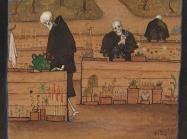




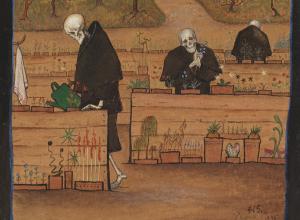


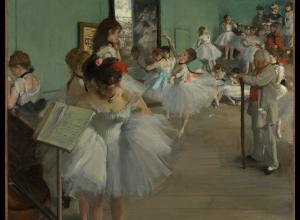



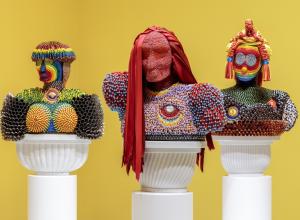





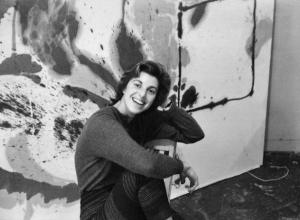
![DEl Kathryn Barton [Australian b. 1972] the more than human love , 2025 Acrylic on French linen 78 3/4 x 137 3/4 inches 200 x 350 cm Framed dimensions: 79 7/8 x 139 inches 203 x 353 cm](/sites/default/files/styles/image_5_column/public/ab15211bartonthe-more-human-lovelg.jpg?itok=wW_Qrve3)



